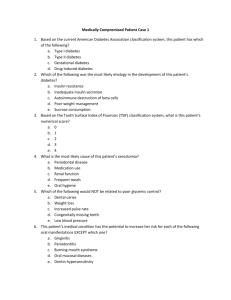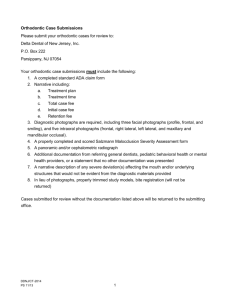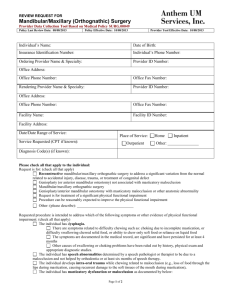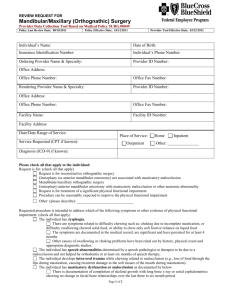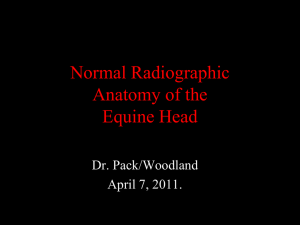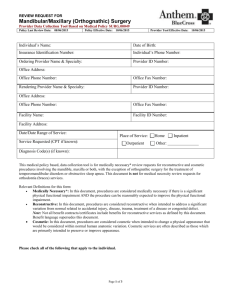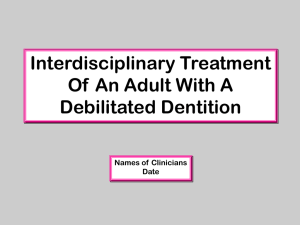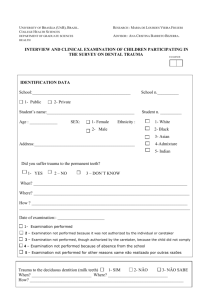Dental.Anatomy.Test
advertisement
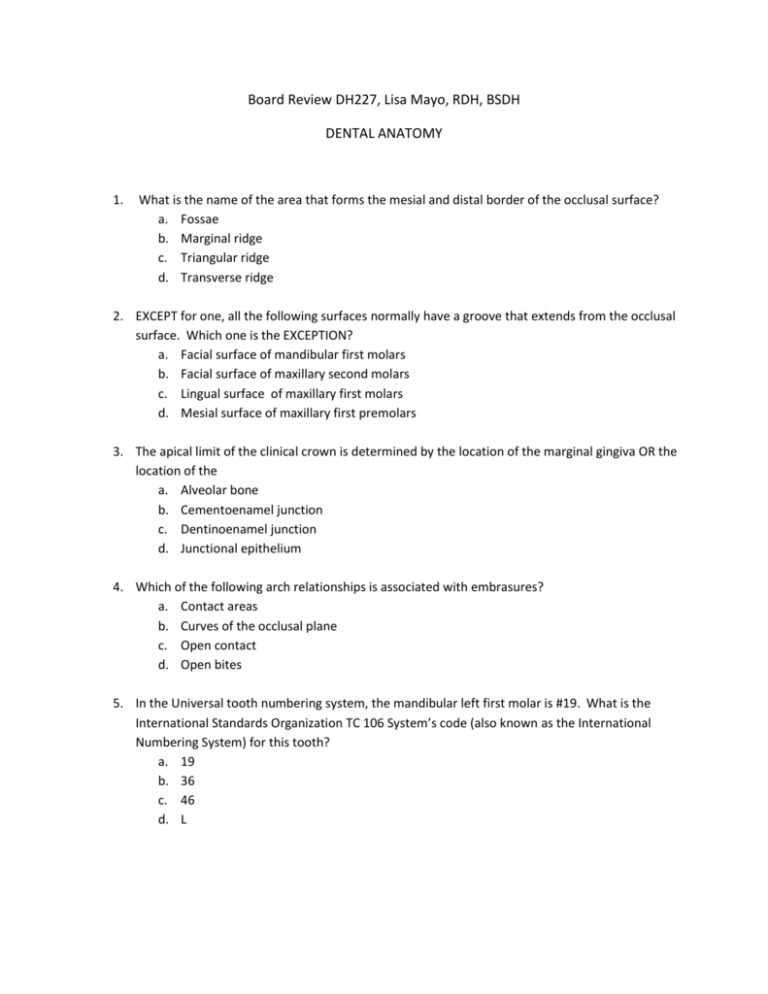
Board Review DH227, Lisa Mayo, RDH, BSDH DENTAL ANATOMY 1. What is the name of the area that forms the mesial and distal border of the occlusal surface? a. Fossae b. Marginal ridge c. Triangular ridge d. Transverse ridge 2. EXCEPT for one, all the following surfaces normally have a groove that extends from the occlusal surface. Which one is the EXCEPTION? a. Facial surface of mandibular first molars b. Facial surface of maxillary second molars c. Lingual surface of maxillary first molars d. Mesial surface of maxillary first premolars 3. The apical limit of the clinical crown is determined by the location of the marginal gingiva OR the location of the a. Alveolar bone b. Cementoenamel junction c. Dentinoenamel junction d. Junctional epithelium 4. Which of the following arch relationships is associated with embrasures? a. Contact areas b. Curves of the occlusal plane c. Open contact d. Open bites 5. In the Universal tooth numbering system, the mandibular left first molar is #19. What is the International Standards Organization TC 106 System’s code (also known as the International Numbering System) for this tooth? a. 19 b. 36 c. 46 d. L 6. What is the relationship between #20 and tooth K? a. Both are mandibular second premolars b. Both are mandibular second premolars c. Is the same tooth in different tooth identification systems d. Tooth #20 replaces K 7. What dental anatomy is common ONLY to multi-rooted teeth? a. Apical foramen b. Fossa c. Furcal concavity d. Pulp horns 8. Which of the following anatomical characteristics is similar in the primary and permanent molars? a. Extension of the pulp horns b. Location of the root trunk c. Number of roots d. Thickness of the enamel 9. Which furcal root surface of molars is LEAST likely to have a concavity? a. Mesial root of the mandibular first molar b. Distal root of the mandibular first molar c. Mesiobuccal root of the maxillary first molar d. Lingual root of the maxillary first molar 10. To determine if there is a furcation involvement of a maxillary second molar, the clinician should probe the a. Midfacial and midlingual areas b. Both proximal surfaces c. Both proximal surfaces and midfacial area d. Both proximal surfaces and midlingual area 11. What tooth anatomy is common ONLY to anterior teeth? a. Cingulum b. Fossa c. Pits d. Marginal ridges 12. The CEJ curves the greatest on the a. Facial and lingual surfaces of anterior teeth b. Facial and lingual surfaces of posterior teeth c. Proximal surfaces of anterior teeth d. Proximal surfaces of posterior teeth 13. Which tooth has a mesial furcation and the longest root trunk? a. Mandibular first premolar b. Maxillary first premolar c. Mandibular first premolar d. Maxillary first molar 14. Each of the following is a normal anatomic change associated with aging EXCEPT one. Which is the exception? a. Attrition of the occlusal/incisal surfaces b. Decrease in the size of the pulp cavity c. Formation of cementum at the root apex d. Formation of mammelons 15. Which of the following teeth is the LEAST likely to have proximal root concavities? a. Maxillary central incisors b. Maxillary canine c. Mandibular central incisor d. Mandibular canine 16. An oblique ridge separates the central and distal occlusal fossae. Mandibular molars have an oblique ridge. a. Both statements are TRUE b. Both statements are FALSE c. The first statement is TRUE, the second statement is FALSE d. The first statement is FALSE, the second statement is TRUE 17. Which of the following proximal surfaces is more easily reached from the lingual? a. Proximal surfaces of maxillary incisors and mandibular incisors b. Proximal surfaces of maxillary incisors and mandibular premolars c. Proximal surfaces of maxillary and mandibular premolars d. Proximal surfaces of mandibular incisors and maxillary incisors 18. What are the last succedaneous teeth to erupt? a. Maxillary second molars b. Third molars c. Maxillary first premolars d. Maxillary canines 19. What permanent tooth replaces the first primary molar? a. First premolar b. Second premolar c. First molar d. Second molar 20. When do the primary teeth begin to develop? a. 4-6 weeks in-utero b. 8-10 weeks in-utero c. 12-14 weeks in-utero d. 18-20 weeks in-utero 21. Normally, a child has a mixed dentition between the ages of ____ and _____. a. 24 months and 6 years b. 6 years and 10 years c. 6yyears and 13 years d. 8 years and 16 years A mother of 3 children is concerned about the eruption of her children’s teeth. John is almost 12, Susan is 10 and Marilyn is 14 months old. 22. If John, age 12, has followed the normal eruption pattern, what primary teeth would he still have? a. Maxillary primary canines b. Maxillary and mandibular primary canines c. Maxillary first primary molars d. Maxillary second primary molars 23. Susan, age 10, is concerned about her appearance. The following are expected oral appearances EXCEPT one. Which one is the exception? a. Crowding b. Darker color of the permanent teeth c. Enlarged, edematous gingivia d. Primate spacing 24. If Marilyn, age 14 months, has followed the normal eruption pattern, what primary teeth are erupted? a. Central incisors b. Lateral incisors c. Canines d. First molars 25. When are the roots of the permanent teeth fully formed? a. At the time of eruption b. 6 months after eruption c. 1 year after eruption d. 2 years after eruption 26. In addition to the central incisors, what permanent teeth would you expect to see in an 8yr old child? a. Canine and 1st molars b. First pm and first molars c. Lateral incisors and canine d. Lateral incisors and 1st molars 27. An edge-to-edge tooth relationship is correctly described as: a. A disturbance in intraarch alignment b. A normal tooth relationship c. Insufficient intercuspation d. Insufficient overbite 28. Which of the following teeth guide protrusive mandibular movement? a. Canine b. Incisors c. Centric cusps of the molars d. Non-centric cusps of the molars 29. What relationship of the primary molars guides the eruption of the first permanent molars in an end-to-end relationship? a. Primate spaces b. Terminal step between the distal surface of the maxillary and mandibular primary molars c. Terminal plane between the distal surface of the maxillary and mandibular primary molars d. Tooth version 30. A maxillary first molar is approximately 12mm in length. How many millimeters from the CEJ would a clinician feel a furcation? a. 2mm b. 4mm c. 6mm d. 8mm 31. What is the largest and longest root of the maxillary molars? a. Mesiobuccal b. Distobuccal c. Lingual d. All roots are equal in size and length 32. If the mandibular molars are lost and not replaced, over time which of the following is the MOST probable effects on the position of the maxillary left molar? a. Mesial drift b. No change c. Rotation d. Super-eruption 33. Tooth #3 is in a normal axial position; tooth #30 is in buccal version. What is the MOST likely relationship of tooth #3 and tooth #30? a. Crossbite b. Excessive overjet c. Excessive overbite d. Open bite 34. In centric occlusion, the mesiobuccal cusp of tooth #14 is in the facial embrasure of tooth #19 and #20. What is the classification of malocclusion? a. Neutral b. I c. II d. III 35. Which of the following occurs in lateral mandibular movements of a young adult? a. Canines on the working side guide the movement b. Incisors guide the movement c. Molars on the balancing side guide the movement d. There is contact of the maxillary and mandibular posterior teeth 36. During an assessment of interarch relationships the clinician notes enlarged, reddened gingiva on the lingual surface of teeth #7-10. What is the MOST likely cause? a. Anterior crossbite b. Anterior openbite c. Excessive overbite d. Excessive overjet 37. When a tooth is turned from its normal intra-arch alignments, it is in a. Facioversion b. Infraversion c. Supraversion d. Torsoversion 38. Which of the following interarch relationships is associated with the axial positioning of anterior teeth? a. Intercuspation b. Interdigitation c. Overbite d. Overjet 39. The following facilitate the intercuspation of maxillary and mandibular posterior teeth, EXCEPT one. Which one is the exception? a. Axial position of the mandibular posterior teeth toward the median plane b. Axial position of the maxillary posterior teeth parallel to the median plane c. Axial position of the maxillary posterior teeth more parallel to the horizontal plane d. Lingual inclination of the crown of mandibular posterior teeth 40. Which of the following is characteristic of an open bite? a. A disturbance in intraarch alignment b. Deviation in the arch form c. Lack of incisal or occlusal contact d. Insufficient overjet 41. Which tooth has a functional buccal cusp and a functional lingual cusp? a. Maxillary canine b. Mandibular first premolar c. Maxillary second premolar d. Mandibular second premolar 42. The degree of mineralization of normal cementum is approximately that of: a. Bone b. Dentin c. Enamel d. Cartilage 43. Which of the following transmits the sensation of contact when teeth are occluding? a. Dental pulp b. Periodteum c. Alveolar bone d. Attached gingiva e. PDL 44. Resilience and firmness of the gingiva are due primarily to a. Vascularity b. Endothelium c. Fluid exudate d. Cellular elements e. Collagenous tissue 45. Which part of the root has the thickest layer of cementum? a. Apical third of the root b. Middle third of the root c. Coronal third of the root d. Exposed root surface 46. The suture between the premaxilla and the palatine process of the maxilla lies between a. Central incisors b. Lateral incisor and canine c. Canine and first premolar d. Central and lateral incisors 47. Which of the following attach the PDL to cementum? a. Cementoblasts b. Sharpey’s fibers c. Stillman’s fibers 48. A patient complain of being unable to experience touch, pain, hot, cold or pressure on the anterior 2/3 of his tongue. The affected nerve is the: a. Vagus b. Lingual c. Hypoglossal d. Chorda tympani e. Glossopharyngeal 49. Reduced enamel epithelium plays an important role in which of the following? a. Dentin formation b. Enamel formation c. Enamel maturation d. Epithelial attachment formation e. Outlining the DEJ 50. Histologically, gingival epithelium most closely resembles epithelium of the a. Soft palate b. Hard palate c. Vestibular mucosa d. Transitional zone of the lips 51. From where does the cementum gain its nourishment? a. Pulp b. Odontoblasts c. Cementoblasts d. PDL 52. Which cell is injured when the tooth overheats during an amalgam preparation? a. Osteocyte b. Osteoblast c. Ameloblast d. Odontoblast 53. Which of the following is a protective pulpal response to external irritants? a. Pulp stone b. Pulpal fibrosis c. Reparative dentin d. Internal resorption e. Secondary cementum 54. The nasopalatine nerve is a branch of which division of the trigeminal nerve? a. Occipital division b. Maxillary division c. Opthalmic division d. Mandibular division 55. The action of the medial pterygoid muscle to a. Elevate the mandible b. Depress the mandible c. Elevate the lip during a smile d. Elevate the hyoid bone during speech 56. Which tooth has a developmental groove on the mesial surface of both crown and root? a. Maxillary first premolar b. Maxillary central incisor c. Mandibular first premolar d. Maxillary second premolar 57. Eruption of the permanent maxillary central incisor commonly occurs at: a. 6-7 years of age b. 3-4 years of age c. 7-9 years of age d. 4-5 years of age 58. Which premolar usually has two roots? a. Maxillary canine b. Mandibular canine c. Maxillary first premolar d. Maxillary second premolar 59. Which of the following premolar teeth often has 3 cusps? a. Maxillary first premolar b. Mandibular first premolar c. Maxillary second premolar d. Mandibular second premolar 60. The state of teeth joined together only by cementum is diagnosed as: a. Fusion b. Budding c. Gemination d. Concrescence 61. Two tooth buds are joined together during development and may clinically as a macrodont. The probable diagnosis is: a. Fusion b. Budding c. Gemination d. Concrescence 62. A radiograph shows that the roots of a lower molar are severely curved to almost 90 degrees. This is diagnosed as: a. Hypoplasia b. Dilaceration c. Turner’s tooth d. Hutchinson’s tooth 63. Which of the following is the most common site for a supernumerary tooth? a. Between the mand incisors b. Distal to the maxillary third molar c. Between the mand bicuspids d. Between the max central incisors 64. A patient has lost enamel on the anterior teeth of a lemon-sucking habit. The diagnosis is: a. Erosion b. Attrition c. Abrasion d. Chemico-attrition ANSWERS 1.B 2.B 3.D 4.A 5.B 6.D 7.C 8.C 9.D 10.C 11.A 12.C 13.B 14.D 15.A 16.C 17.B 18.D 19.A 20.A 21.C 22.A 23.D 24.C 25.D 26.D 27.D 28.B 29.C 30.B 31.C 32.D 33.A 34.C 35.A 36.C 37.D 38.D 39.C 40.C 41.B 42.A 43.E 44.E 45.A 46.B 47.B 48.B 49.D 50.B 51.D 52.D 53.C 54.B 55.A 56.A 57.A 58.A 59.D 60. D 61. A 62. B 63. D 64. A Reasoning and Rationales 1. Occ surface bounded on the M and D by ridges called marginal ridges 2. a.) 2 grooves extend from occ surface onto the F surface of mand 1st molars c.) A groove extends from occ surface onto the L of max 1st molars d.) Groove extends over marginal ridge onto the M of max 1st pm 3. Clinical crown is the portion of tooth visible in oral cavity OR the unattached portion of tooth; junctional epithelium is the apical limit of unattached gingiva 4. Interprox spaces that begin at the contact area and widen toward the F/L/O/I/Cervial 5. Also known as the International Numbering System 7. Only multi-root teeth will have furcations 8. primary molars have the same number of roots as perm molars; max molars have 3 roots, mand molars have only 2 roots 9. Only 17% of L roots of max 1st molars have a furcal concavity 10. Max 2nd molar has 3 furcations: F/M/D 12. On proximal surfaces of ant teeth the CEJ curves apically in a ‘V’ shape a.) On F and L surfaces of ant teeth the CEJ is a gradual convexd curve b.) CEJ curves less on the F and L surfaces of post teeth d.) CEJ curves slightly on the proximal surfaces of post teeth 15. The root of a max central incisor is convex, with no root concavities b.) proximal root concavities are expected on a max canine c.) root of a mand central incisor has prominent proximal root concavities d.) proximal root concavities are expected on a mand canine 16. Only max molars have an oblique ridge 17. Max incisor and mand premolar roots are triangular ovoid in shape; the L surface is smaller than the F creating a wider L embrasure area 27. Max teeth do not overlap the mand teeth a.) Involves both arches, it is a disturbance in interarch alignment b.) normal for max teeth to overlap mand teeth c.) Intercuspation involves post teeth; in a cusp-to-cusp bite there is insufficient intercuspation 28. Protrusion is guided by the incisors, and is called incisal guidance a.) Canine guide lateral movement c.) Post teeth disengage protrusive movements d.) post teeth disengage in protrusive movements 29. A flush, terminal plane relationship of the primary molars will guide the perm 1st molars into an end-to-end relationship a.) Primate spaces is a spacing pattern between the maxillary lateral and canine and the mand canine and 1st primary molar st b.) 1 perm molars will erupt in a normal relationship if there is a terminal step relationship d.) Tooth version are disturbances in intrarach alignment; versions involve individual tooth position 30. Furcations in molars being near the junction of he cervical and middle thirds of the root, 3-5mm from CEJ 33. #30 is in buccal version, #3 lingual to tooth #30, this is a crossbite 37. Torsoversion refers to the rotation of a tooth in the alveolus a.) Facial version refers to the F position of a tooth in relation to overall curvature of the arch b.) Infraversion refers to the less than full eruption of a tooth into occlusion c.) Supraversion refers to the eruption of a tooth past the occlusal plane 38. Ant teeth normally “sit” at a 60 degree angle to the horizontal plane. This places the crowns in a definite F position. Overjet is the position of the maxillary teeth in a horizontal direction 39. The axial position in relation to the horizontal plane affects the amt of overjet of ant teeth a.) The axial position of the man post teeth toward themedican plane brings the F cusps into intercuspation in the occ surface of the max post teeth b.) Axial position of max post teeth more parallel to the median plane brings the L cusps into intercuspation in the occ surface of the man post teeth d.) L inclination of the crowns of post teeth brings the F cusps into intercuspation in the occ surface of the max post teeth DENTAL ANATOMY QUESTIONS PART 2 Q&A PREPARRED BY FACULTY AT KANSAS CONCORDE COLLEGE CAMPUS 1. Which of the following provides the most reliable criterion for differentiating permanent mandibular central incisors from permanent mandibular lateral incisors? a. Difference in root length b. Difference in ratio of crown length to root length c. Degree of slope of the incisal edge when viewed facially d. Difference in rotation of the crown on the root 2. How does the distoincisal angle of most anterior teeth compare to the mesioincisal angle? a) It is straighter b) It is more rounded c) There is no difference 3. A cingulum is normally located: a) At the cervical third of the lingual surface of anterior teeth b) At the incisal third of the lingual surface of anterior teeth c) At the middle third of the lingual surface of anterior teeth d) At the cervical third of the lingual surface of posterior teeth 4. When viewed from the labial or lingual aspect, the crowns of all mandibular and maxillary incisors appear to have a: a) Triangular outline b) Trapezoidal outline c) Rhomboidal outline d) rectangular outline 5. Of the two mandibular incisors, which has a root that is larger in all dimensions? a) Mandibular central incisor b) Mandibular lateral incisor 6. The mesial and distal aspect (or surfaces) of all anterior teeth have a: a) Trapezoidal outline b) Triangular outline c) Rhomboidal outline d) Square outline 7. What single feature distinguishes the permanent mandibular lateral incisor from the permanent mandibular central incisor when looking at them from an incisal view? a) The lateral incisor has a cingulum that is more centered on the lingual surface b) The marginal ridges of the lateral are the same length c) The incisal edge of the lateral has distolingual twist 8. Which of the following is the most common congenitally missing permanent tooth? a) Maxillary lateral incisor b) Third molars c) Mandibular d) First molars 9) A child has maxillary incisors protrusion, an anterior open bite, crowded, crowded lower anteriors, and a high palatal vault. Which of the following most likely caused this problem? a) Mouth breathing b) Thumb sucking c) Tongue thrusting d) Using a pacifier e) Nocturnal bruxism 10) Where is the most common site for a supernumerary tooth to be found? a) Mandibular incisor area b) Maxillary incisor area c) Mandibular molar area d) Maxillary molar area 11) Which of the following are succedaneous teeth? a) The permanent maxillary and mandibular premolars b) The permanent maxillary and mandibular first molars c) The permanent maxillary and mandibular second molars d) The permanent maxillary and mandibular third molars 12) The abnormal or pathological wearing away of tooth structure by a mechanical means is called: a) Erosion b) Abrasion c) Attrition 13) The most distinguishable difference between the maxillary first and second permanent premolars is: a) The size of the crown b) The number of roots c) The curvature of the facial surface d) The length of the lingual cusp 14) The roots of the maxillary canine are generally: a) The shortest in the maxillary arch b) The longest in the dental arch c) Varied more so than other teeth d) Nearly equal to the roots of other anterior teeth 15) Which teeth have the most variable crown shape of all permanent teeth? a) Maxillary lateral incisors b) Mandibular lateral incisors c) Maxillary third molars d) Mandibular second premolars 16) Which tooth frequently exhibits a small fifth cusp attached to the lingual surface of the mesiolingual cusp? a) Maxillary second molar b) Maxillary first molar c) mandibular first molar d) mandibular second molar 17) The smallest tooth in the dental arch is the: a) Maxillary central incisor b) Maxillary lateral incisor c) Mandibular central incisor d) Mandibular lateral incisor 18) Which tooth may show three types of occlusal surfaces? a) Maxillary first premolar b) Mandibular second premolar c) Mandibular first premolar d) Maxillary second premolar 19) The largest permanent tooth in the mandibular arch is the: a) First molar b) Second molar c) Third molar 20) Which tooth has a small DL cusp that can be absent, creating a three-cusp tooth? a) Mandibular second molar b) Maxillary first molar c) Mandibular first premolar d) Maxillary second molar 21) The anterior tooth most likely to have a bifurcated root is the: a) Maxillary central incisor b)Mandibular canine c)Mandibular central incisor d) Maxillary canine 22) A mesio-lingual developmental groove is a positive ID for the: a) Maxillary first premolar b) Mandibular first premolar c) Maxillary second premolar d) Mandibular second premolar 23) The most reliable distinguishing feature of the mandibular third molar is the: a) Fused and compressed root system b) Short, bulbous outline of the crown c) Marginal ridge forming a smooth circle d) Marked distal inclination of the root trunk e) Great morphologic resemblance to the first molar 24) Which tooth has the longest crown length? a) Maxillary canine b) Maxillary lateral incisor c) Maxillary central incisor 25) Which tooth is most likely to have a pronounced concavity on its mesial surface? a) Mandibular first premolar b) Maxillary second premolar c) Maxillary first premolar d) Mandibular second premolar 26) Which molar is the most symmetraical? a) Maxillary second molar b) Maxillary first molar c) Mandibular first molar d) Mandibular second molar 27) Which tooth occasionally exhibits a lingual groove that extends from the enamel onto the cemental area of the root? a) Maxillary centrals b) Mandibular centrals c) Maxillary laterals d) Mandibular laterals 28) The dental pulp is a connective tissue that develops from the: a) Enamel organ b) Dental papilla c) Dental sac 29) The main function is cementum is; a) To compensate for tooth wear by depositing apical cementum b) Reparative in nature c) To provide rough surface anchorage for attachment of Sharpey’s fibers d) Protection of the root surface 30) The peripheral layer of dentin, which is the first layer of dentin deposited, is called: a) Mantle dentin b) Peritubular dentin c) Intertubular dentin d) Interglobular dentin 31) The primary function of the dental pulp is to: a) Protect the periodontium b) Form enamel c) Form dentin d) Assure root-end closure 32) Which of the following cells form cementum? a) Cementoblasts b) Cementoclasts c) Cementocytes d) None of the above 33) The dental lamina is induced to proliferate into a tooth bud by the: a) Basement membrane b) Epithelial nerves c) Ectomesenchyme d) Oral epithelium 34) Which structure is the remnant of the onset of enamel formation? a) Cementoenamel junction (CEJ) b) Dentinoenamel junction (DEJ) c) Pulp chamber d) Mucogingival junction (MGJ) 35) The composition of dentin is: a) 50% organic, 40% inorganic, and 10% water b) 60% organic, 35% inorganic, and 5% water c) 20% organic, 70% inorganic, and 10% water d) 30% organic, 68% inorganic, and 2% water 36) Which layer of the enamel organ is essential for the initiation of dentin formation once enamel is formed? a) Outer enamel epithelium b) Inner enamel epithelium c) Stratum intermedium d) Stellate reticulum 37) Which of the following dentin is formed very rapidly in response to irritants? a) Primary b) Secondary c) Reparative d) Sclerotic 38) The application of excessive heat to a tooth results in pain because: a) Excessive stimulation of a heat receptor always results in pain b) Heat receptors in the pulp have a low threshold to pain c) All stimuli to the pulp results in a pain sensation d) Blood vessels of the pulp expand and cause strangulation of the tissue 39) The fundamental morphologic unit of enamel is the: a) Enamel tuft b) Enamel spindle c) Enamel rod d) Enamel lamellae 40) Root formation is dependent on the orderly growth of: a) Enamel rods b) Hertwig’s epithelial root sheath c) The pulp d) The dental follicle 41) The stage of tooth development in which the physiological process of differentiation occurs to its fullest extent is called: a) Initiation b) Bud stage c) Cap stage d) Bell stage e) Appositional stage f) Maturation stage 42) In its mature state, enamel is: a) 47% mineralized b) 68% mineralized c) 87% mineralized d) 96% mineralized 43) Cervical line (or CEJ) contours are closely related to the attachment of the gingival at the neck of the tooth. The greatest contours of the cervical lines and gingival attachments occur on the: a) Distal surfaces of anterior teeth b) Distal surfaces of posterior teeth c) Mesial surfaces of anterior teeth d) Mesial surfaces o posterior teeth 44) Both maxillary and mandibular premolars and molars have heights of contour approximately in the middle third on the: a) Facial surface of the crown b) Lingual surface of the crown c) Distal surface of the crown d) Mesial surface of the crown 45) The cement-enamel junction (cervical line) of teeth curves towards the apex on the facial and lingual surfaces and: a) Towards the apex on the mesial surface b) Away from the apex on the distal surface c) Towards the apex on the mesial and distal surfaces d) Away from the apex on the mesial and distal surfaces 47) Which term refers to tooth contacts while the mandible is in action, such as during mastication and swallowing? a) Centric relation b) Centric occlusion c) Functional occlusion 48) Which cusp of the maxillary first molar serves as a reference point in identifying Angle’s Class I, II, and III occlusion? a) Distobuccal b) Mesiobuccal c) Mesiolingual d) Distolingual 49) Which of the following facial profiles is usually accompanied by a Class II malocclusion? a) Orthognathic profile b) Retrognathic profile c) Prognathic profile d) None of the above 50) The vertical distance by which maxillary incisors overlap the mandibular incisorsi s referred to as: a) Overjet b) Overbite c) Underjet d) Openbite 51) A fissured groove is most frequently found on the: a) Facial surface of maxillary molars b) Lingual surface of maxillary molars c) Facial surface of mandibular molars d) Lingual surface of mandibular molars 52) Which of the following teeth typically have trifurcations? a) Mandibular molars b) Maxillary molars c) Maxillary premolars d) Mandibular premolars 53) How many roots are visible from the buccal aspect of a maxillary first molar? a) One root b) Two roots c) Three roots d) Four roots 54) From a developmental viewpoint, all mandibular molars have how many major cusps, as compared to how many major cusps on maxillary molars? a) 4:6 b)5:3 c)5:4 d)3:4 55) On a maxillary molar the largest, longest, and strongest of the three roots is the: a) Mesiobucal b) Distobuccal c) Palatal 56) Occlusocervically, the height of the distal marginal ridge of a permanent maxillary first molar is the same height as the: a) Mesial marginal ridge of a maxillary second premolar b) Mesial marginal ridge of a mandibular first molar c) Mesial marginal ridge of a second molar d) Distal marginal ridge of a maxillary second premolar 57) The characteristic common to all mandibular first premolars when viewed from the occlusal aspect is a) The buccal ridge is flat b) The marginal ridges are underdeveloped c) The buccal lobe makes up the majority of the tooth d) The lingual cusp is large 58) Which of the following teeth has a mesial marginal ridge that is distinctly shorter in length and less prominent in height than the distal marginal ridge? a) Maxillary first molar b) Mandibular first premolar c) Mandibular first molar d) Maxillary first premolar 59) The mental foramen is located most closely to the apex of the: a) Mandibular canine b) Mandibular second premolar c) Mandibular first molar d) Maxillary first premolar 60) The buccal and lingual cusps are almost equal in height on the: a) Maxillary first premolar b) Maxillary second premolar 61) Which premolar is the only one that has mesial buccal cusp ridge that is longer than its distal buccal cusp ridge? a) Maxillary first premolar b) Maxillary second premolar c) Mandibuar first premolar d) Mandibular second premolar 62) Any union of two triangular ridges produces a single ridge which is called: a) A cusp ridge b) A marginal ridge c) A transverse ridge d) A proximal ridge 63) A V-shaped area located between the contact point of two teeth and the gingival crest is called: a) A contact area b) An occlusal curvature c) A gingival space d) An embrasure 64) All of the following are true concerning developmental grooves, EXCEPT one. Which one is the EXCEPTION? a) They are broad, deep, linear, depressions b) They are formed during tooth development c) They usually separate the primary parts of the crown or root d) They are important escape ways for cusps during lateral and protrusive jaw motions and for food particles during mastication 65) A small elevation of enamel found on the crown portion of a tooth would be classified as a: a) Tubercle b) Mammelon c) Ridge d) Developmental depression 66) A long depression or a V-shaped valley on the occlusal surface of a posterior tooth between ridges and cusps is referred to as a: a) Fossa b) Fissure c) Pit d) Sulcus 67) The minimum number of lobes from which any tooth may develop is: a) Two b) Three c) Four d) Five 68) The interdental space is the (that): a) Occlusal (incisal border) at which the gingival meets the tooth b) Portion of the gingival that fills the interproximal space c) Collar of tissue that is not attached to the tooth or alveolar bone d) Band or zone or gray to light or coral pink keratinized masticatory mucosa that is firmly bound down to the underlying bone 69) Which of the following statements concerning proximal contact areas is true. a) They support neighboring teeth, which thereby stabilizes dental arches b) They prevent food particles from entering the interproximal areas c) They protect the interdental papillae of the gingival by shunting food toward the buccal and lingual areas d)They form embrasures e) All of the above statements concerning proximal contact areas are true 70) Which of the following types of ridges is unique to permanent maxillary molars? a) A labial ridge b) A marginal ridge c) An oblique ridge d) A transverse ridge 71) The meeting of three surfaces on a tooth is called a: a) Line angle b) Point angle c) Midline d) Developmental depression 72) A maxillary right canine may be distinguished from a maxillary left canine because: a) The root always curves to the distal in the apical one-third b) The distal surface is fuller and more convex than the mesial surface c) Labially, the cusp tip is placed distal to a line which bisects the crown and root d) Lingually, the cervical line slopes mesially 73) Which cusp ridge is the longest on the permanent canines? a) Labial b) Lingual c) Mesial d) Distal 74) A labial ridge is; a) A ridge running cervicoincisally in approximately the center of the labial surface of the centrals b) A ridge running cervicoincisally in approximately the center of the labial surface of the canines c) A ridge running cervicoincisally in approximately the center of the labial surface of the laterals d) A ridge running cervicoincisally in approximately the center of the labial surface of the molars 75) In comparison with the mandibular permanent canine, the maxillary permanent canine in the same mouth: a) Is narrower mesiodistally b) Has a less pronounced cingulum c) Is wider mesiodistally d) Has a shorter root 76) Primate spaces occur in about: a) 10% of children b) 25% of children c) 50% of children d) 75% of children 77) Ordinarily, a six-year-old child would have what teeth clinically visible in the mouth? a) All (20) primary teeth and 4 permanent first molars b) 18 primary teeth and 2 permanent mandibular central incisors c) 18 primary teeth, 2 permanent mandibular central incisors, and 4 permanent first molars 78) All of the following statements are true, EXCEPT one. Which one is the EXCEPTION? a) The primary teeth are lighter in color than the permanent teeth b) The pulp cavities are proportionately smaller in primary teeth c) In general, the crowns of primary teeth are more bulbous and constricted than the permanent counterpart d) The crown surfaces of all primary teeth are much smoother than the permanent teeth (in other words, there is less evidence of pits and grooves) 79)The primary maxillary lateral incisor typically erupts when a child is about: a) 8 months old b) 16-22 months old c) 13-19 months old d) 25-33 months old 80) The primary first molars are usually exfoliated between what ages? a) 6-8 years old b) 7-9 years old b) 9-11 years old c) 8-10 years old d) 12-14 years old 81) The permanent maxillary lateral incisor typically erupts around what age? a) 6-7 years old b) 8-9 years old c) 11-12 years old d) 12-14 years old ANSWERS 1.D 2.B 3.D 4.B 5.B 6.B 7.C 8.B 9.B 10.B 11.A 12.B 13.B 14.B 15.C 16.B 17.C 18.B 19.A 20.D 21.B 22.B 23.D 24.C 25.C 26.D 27.C 28.B 29.C 30.A 31.C 32.A 33.C 34.B 35.C 36.B 37.C 38.C 39.C 40.B 41.D 42.D 43.C 44.B 45.D 46.OMIT 47.C 48.B 49.B 50.B 51.B 52.B 53.C 54.C 55.C 56.C 57.C 58.B 59.B 60.B 61.A 62.C 63.D 64.A 65.A 66.D 67.C 68.B 69.E 70.C 71.B 72.B 73.D 74.B 75.C 76.C 77.A 78.B 79.A 80.B 81.B
